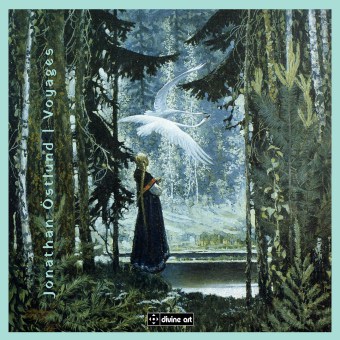Fanfare
This new release of music by Jonathan Östlund is intended as “a reflection on the nature of our common yet unique journeys through time”; in doing so, it creates its own set of memories. Along the way, folk music, Grieg, Bach and Debussy all cast their respective shadows, while there are two texts set by Östlund: the famous Clair de lune of Verlaine (Manon Gleizes, soprano, charming us with pianist Harry Põlda), and Goethe’s equally well-known Erlkönig (book-ended by Nature sounds, a powerful setting with active piano part, Artyom Safronov and Evgheny Brakhman the intrepid performers). All of these references act as, in the composer’s own words, “bridges through time”. Unfolding over a nearly three hour span, Voyages is cast in two roughly equal parts (87 and 80 minutes).
Recorded birdsong informs the very opening “L’al di là Theme”; memories of Rautavaara are inevitable, as well as of Östlund’s own Divine Art double album Lunaris (Fanfare 39:4). But Östlund goes his own way, a solo clarinet (Christine Hoerning) carrying the weight of Messiaen on its shoulders (the color indication for “L’al di là Theme” is, no coincidence I am sure: “Dreamy, shimmering in blue”), before a more jazzy piano enters, walking bass and all, for “Etesian,” cleanly played by Evgheny Brakhman (he gets to show his more sensitive side in “Moonlight Weave”).
The compositional reach over Voyages is wide, from complex orchestra to simple, effective piano writing (the “Folklore Fantasia,” with all its embedded memories of Grieg, superbly, and fetchingly, played by Sasha Grynyuk).
It is perhaps the more lyrical movements that are most memorable. The violin’s soulful song of “Twilight-wind and Mandolin” (Alicia Śmietana with Sasha Grynyuk) is truly touching, while the solo violin “Air on a Grieg Theme” (Śmietana, closely recorded but with just the right amount of reverb), short though it is, reveals core aspects of the composer’s skill: earthy from one angle but revealing underlying sophistication. Śmietana and Grynyuk also impress in the folksy violin and piano “Minuit et mistrale.”
The orchestral writing is expert, dense in a Nordic symphonic way, powerful and expressive in both “Veils of Night” and “The Aura,” the Symphony Orchestra of Norrlandsoperan (Umeå, Sweden) in fine form. Chamber writing is handled with a light touch: the Ensemble NEO (sometimes called Norbotten NEO), is a superb group in the playful, imaginative “The Wizard,” while Duo Almira, comprising flute and bassoon, provide the most relaxing, assured account of the five-movement “Jeux pour Deux.” Trio Tempora offers the delicious Sunday afternoon-ish music of “Sonatine Lyrique,” while the shadowy and occasionally deliberately lumbering “Oblivion” for piano quartet receives a marvelous performance by violinist Vladimir Spektor, violist Ksenia Zhuleva, cellist Alexander Zagorinsky and pianist Einar Steen-Nøkleberg.
Those references to other composers offer another thread that runs through Voyages. The Debussy comes in “Syrinx et Pan (Fantasia sur le “Syrinx” de Debussy)”; in addition, Ostlund offers what is effectively “his” Syrinx in the piece “Air dans l’air”. But it is his solo piano Fantasia on Bach’s “Badinerie” that really impresses; at a mere 3”20, this would be a fine encore piece, creative, energetic, playful (Brakhman again in fine fettle, his articulation superb). At times an unraveling of Bach, the piece works beautifully. There are references to ancient music, too, firstly in “Dacian Prayer” (a reference to the ancient country of South-Eastern Europe, Dacia) filtered through Östlund’s ears and played hauntingly by Zagorinsky and Steen-Nøkleberg. Then, “Two Fantasias on Ancient Hymns” for organ, well played by Walter Gatti.
There cannot be too many pieces for violin and organ, but Östlund provides “Gate of Northern Lights,” gritty, craggy and superbly played here by Elena Saccomandi, who joins Gatti. Gothic might be a good description of this highly effective piece. The organ used needs some explanation: quote, “the Waldensian Church in Luserna San Giovanni, using the electronic organ Rodgers 525 to drive a ‘Hauptwerk’ system, with the organ samples of the Walcker organ of the ‘Grote Kerk’ (Wildervank, NL), and samples of the Brindley and Foster organ in the church of St. Anne (Park Hill, Moseley, Birmingham, UK).”
A wide-ranging experience, then, and certainly one worthy of investigation.
@divineartrecordingsgroup
A First Inversion Company
Registered Office:
176-178 Pontefract Road, Cudworth, Barnsley S72 8BE
+44 1226 596703
Fort Worth, TX 76110
+1.682.233.4978












